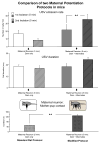Ultrasonic vocalizations: a tool for behavioural phenotyping of mouse models of neurodevelopmental disorders
- PMID: 18771687
- PMCID: PMC2688771
- DOI: 10.1016/j.neubiorev.2008.08.003
Ultrasonic vocalizations: a tool for behavioural phenotyping of mouse models of neurodevelopmental disorders
Abstract
In neonatal mice ultrasonic vocalizations have been studied both as an early communicative behaviour of the pup-mother dyad and as a sign of an aversive affective state. Adult mice of both sexes produce complex ultrasonic vocalization patterns in different experimental/social contexts. Vocalizations are becoming an increasingly valuable assay for behavioural phenotyping throughout the mouse life-span and alterations of the ultrasound patterns have been reported in several mouse models of neurodevelopmental disorders. Here we also show that the modulation of vocalizations by maternal cues (maternal potentiation paradigm) - originally identified and investigated in rats - can be measured in C57BL/6 mouse pups with appropriate modifications of the rat protocol and can likely be applied to mouse behavioural phenotyping. In addition we suggest that a detailed qualitative evaluation of neonatal calls together with analysis of adult mouse vocalization patterns in both sexes in social settings, may lead to a greater understanding of the communication value of vocalizations in mice. Importantly, both neonatal and adult USV altered patterns can be determined during the behavioural phenotyping of mouse models of human neurodevelopmental and neuropsychiatric disorders, starting from those in which deficits in communication are a primary symptom.
Figures


Similar articles
-
Ultrasonic vocalizations in rat and mouse pups.Curr Protoc Neurosci. 2002 Feb;Chapter 8:Unit 8.14. doi: 10.1002/0471142301.ns0814s17. Curr Protoc Neurosci. 2002. PMID: 18428567
-
Ultrasonic vocalizations in Shank mouse models for autism spectrum disorders: detailed spectrographic analyses and developmental profiles.Neurosci Biobehav Rev. 2014 Jun;43:199-212. doi: 10.1016/j.neubiorev.2014.03.021. Epub 2014 Apr 12. Neurosci Biobehav Rev. 2014. PMID: 24726578 Review.
-
Behavioral phenotyping of mouse models of neurodevelopmental disorders: relevant social behavior patterns across the life span.Behav Brain Res. 2007 Jan 10;176(1):40-52. doi: 10.1016/j.bbr.2006.08.024. Epub 2006 Sep 22. Behav Brain Res. 2007. PMID: 16996147 Review.
-
Ultrasonic vocalizations as a fundamental tool for early and adult behavioral phenotyping of Autism Spectrum Disorder rodent models.Neurosci Biobehav Rev. 2020 Sep;116:31-43. doi: 10.1016/j.neubiorev.2020.06.011. Epub 2020 Jun 13. Neurosci Biobehav Rev. 2020. PMID: 32544538 Review.
-
Alterations in the ultrasonic vocalization sequences in pups of an autism spectrum disorder mouse model: A longitudinal study over age and sex.Prog Neuropsychopharmacol Biol Psychiatry. 2025 Jun 20;139:111372. doi: 10.1016/j.pnpbp.2025.111372. Epub 2025 Apr 22. Prog Neuropsychopharmacol Biol Psychiatry. 2025. PMID: 40274253
Cited by
-
Sex-specific modulation of early life vocalization and cognition by Fmr1 gene dosage in a mouse model of Fragile X Syndrome.Biol Sex Differ. 2024 Feb 21;15(1):18. doi: 10.1186/s13293-024-00594-3. Biol Sex Differ. 2024. PMID: 38383408 Free PMC article.
-
Translational animal models of autism and neurodevelopmental disorders.Dialogues Clin Neurosci. 2012 Sep;14(3):293-305. doi: 10.31887/DCNS.2012.14.3/jcrawley. Dialogues Clin Neurosci. 2012. PMID: 23226954 Free PMC article. Review.
-
Autism-related deficits via dysregulated eIF4E-dependent translational control.Nature. 2013 Jan 17;493(7432):371-7. doi: 10.1038/nature11628. Epub 2012 Nov 21. Nature. 2013. PMID: 23172145 Free PMC article.
-
Juvenile Shank3b deficient mice present with behavioral phenotype relevant to autism spectrum disorder.Behav Brain Res. 2019 Jan 1;356:137-147. doi: 10.1016/j.bbr.2018.08.005. Epub 2018 Aug 19. Behav Brain Res. 2019. PMID: 30134148 Free PMC article.
-
Contrasting characteristic behaviours among common laboratory mouse strains.R Soc Open Sci. 2019 Jun 12;6(6):190574. doi: 10.1098/rsos.190574. eCollection 2019 Jun. R Soc Open Sci. 2019. PMID: 31312505 Free PMC article.
References
-
- Antonelli T, Tomasini MC, Tattoli M, Cassano T, Tanganelli S, Finetti S, Mazzoni E, Trabace L, Steardo L, Cuomo V, Ferraro L. Prenatal exposure to the CB1 receptor agonist WIN 55,212–2 causes learning disruption associated with impaired cortical NMDA receptor function and emotional reactivity changes in rat offspring. Cereb Cortex. 2005;15:2013–2020. - PubMed
-
- Barron S, Gilbertson R. Neonatal ethanol exposure but not neonatal cocaine selectively reduces specific isolation-induced vocalization waveforms in rats. Behav Genet. 2005;35:93–102. - PubMed
-
- Blumberg MS, Alberts JR. Ultrasonic vocalizations by rat pups in the cold: an acoustic by-product of laryngeal braking? Behav Neurosci. 1990;104:808–817. - PubMed
-
- Blumberg MS, Sokoloff G. Do infant rats cry? Psychol Rev. 2001;108:83–95. - PubMed
-
- Bolivar VJ, Brown RE. The ontogeny of ultrasonic vocalizations and other behaviors in male jimpy (jp/Y) mice and their normal male littermates. Dev Psychobiol. 1994;27:101–110. - PubMed
Publication types
MeSH terms
Substances
Grants and funding
LinkOut - more resources
Full Text Sources
Medical

